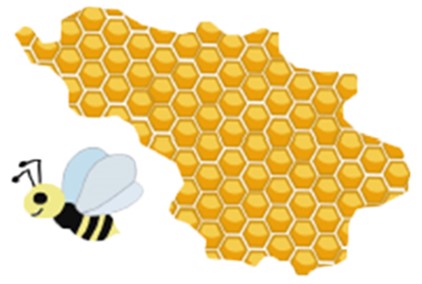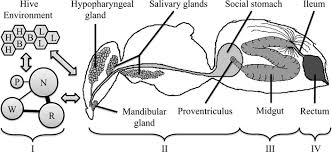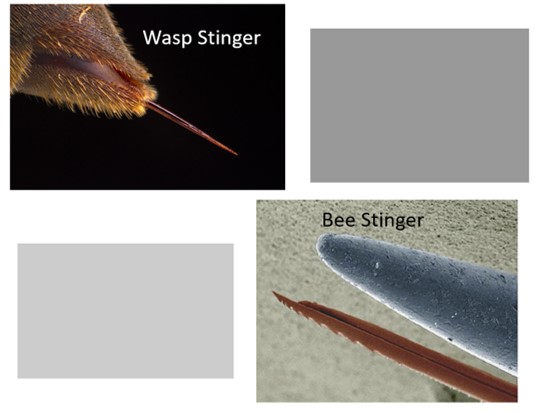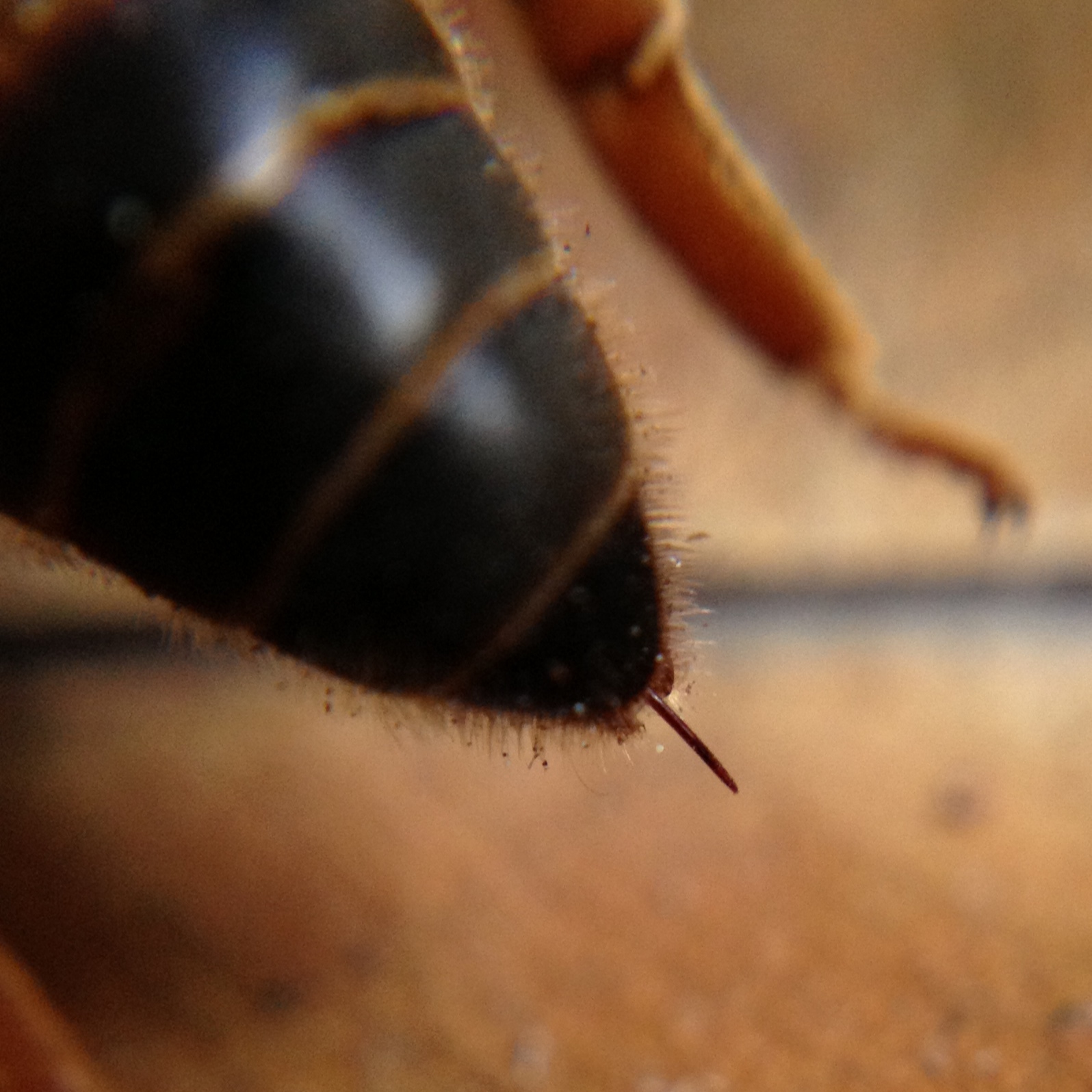Physiology of a Honey Bee
Respiratory System

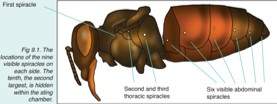

Enlarged photo of a spiracle
Here are the core components a bee’s breathing system?
- Spiracles – This is the term for the external openings that regulate air flow in and out of the bee, of which in the case of the honey bee, there are ten for example.
- Tracheae – These are complex tube-like organs that divide further to form air sacs.
- Air sacs – The sacs serve as reservoirs (storage) for oxygen and are an extension of the tracheae.
Below is a step-by-step overview of how the bee respiratory system works:
- The spiracles (7 pairs on the abdomen, 3 pairs on the thorax) open to allow oxygen to be vacuumed into the tracheae.
- Each single spiracle has a valve that regulates flow of air.
- The spiracles connect directly with the tracheae arms which widen further until bags called air sacs are reached.
- Air sacs are usually large in volume and equally contract to hasten tissue oxidation.
- The air sacs branch even further to form tracheoles which penetrate as far as individual tissues.
- When breathing out, tissues deposit de-oxygenated air ( carbon dioxide) into the tracheoles.
- Tracheoles further pump out the C02 until it reaches the tracheae which release it to the outside via the spiracles
Visit: "Understanding the Respiratory System" for more info on this subject.
Hypopharyngeal and Mandibular Glands
ROYAL JELLY
Royal jelly, a substance secreted by the hypopharyngeal glands of worker honey bees, stimulates the growth and development of queen honey bees. It is highly perishable and one of the most difficult of all foods to harvest, commanding astronomical prices because of its scarcity and high demand, fueled by belief in its healing properties. What royal jelly can do for humans is controversial, but it purportedly reinvigorates the body and extends the life span. Pantothenic acid, a major ingredient, is useful in treating some bone and joint disorders. Rheumatoid arthritis symptoms may subside with the injection of this acid. When pantothenic acid is combined with royal jelly, even better results are reported. This product is sold by many health food companies.
FOR DECADES, SCIENTISTS thought an excess of something special, a substance called royal jelly, elevated a regular honey bee larva to a queen. New research suggests we had it backward: It’s what future queens aren’t fed that matters.
Royal jelly, which also is called "bee milk," looks like white snot. More than half of it is water, the rest is a combination of proteins and sugars. Special glands in the heads of worker bees secrete the stuff, which gets fed to babies.
A developing queen bee is fed royal jelly exclusively—not pollen and honey like her proletarian sisters. Some describe withholding royal jelly from worker bees as nutritional castration. These bees don’t get the special Food of the Gods. Or, perhaps, food of genetic monarchies. And so, we thought, their ovaries shrivel, and they don’t become a queen.
It turns out, it’s the other way around. Not feeding an immature queen pollen and honey is what makes her royal, not her exclusive access to royal jelly.
Visit: "Understanding the Respiratory System" for more info on this subject.
Proboscus (Straw-like appendage)
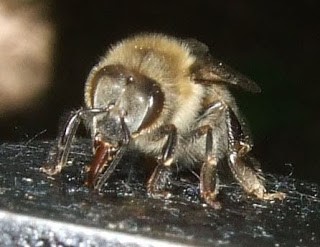


Comparison of proboscis of the caste.
The proboscis is used to collect the nectar from plants. It is also used for food exchange between honey bees, a process called trophallaxis. Food is transferred from bee to bee during the honey-making process, but trophallaxis is also a method of information exchange. The extended proboscis is about 6.5 mm (1/4-inch) long, a length needed to reach deep into many different flowers. In comparison, a bumble bee proboscis may be three times (3/4 inch) the length of the honey bee. During the transfer of the honey/nectar, from one bee to another, evaporation of water takes place. (Note: nectar is 60-80% water. Honey is 18-20% water. (Note: The amount of water allowed in honey may vary depending upon the nectar source.)
Honey Stomach

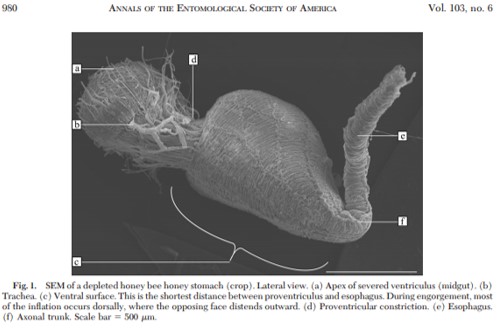
Comparison of proboscis of the caste.
In the honey stomach, the nectar is mixed with what is known as the bee enzyme called invertase, and it is this which starts to transform the raw nectar’s sucrose into glucose and fructose which are monossacharides (basic sugars).
These sugars form the bulk of what is ‘honey’, although , there are also many minor complex sugars.
The worker honey bees return to the bee hive or nest with a full honey stomach. The digested nectar and bee enzyme solution is then regurgitated from the mouths of the forager (worker) bees into the mouths of house bees.
The house bees reduce the moisture component of the mixture by ingesting and regurgitating it, then depositing it into the honeycomb cells.
After this, the bees fan the honey, to reduce the water content further. When the bees decide the honey is ready, it is ‘capped’. It is the capping of honey that is a signal to beekeepers, who will then take some of the honey stores.
Honey never is mixed with digesting food in the intestinal tract, it is inaccurate to refer to honey as ‘bee vomit.’ A dictionary definition of vomit includes ‘disgorging the stomach contents through the mouth.’ Since a human does not have a crop, the stomach is in direct contact with the esophagus and mouth. In a bee, the proventriculus and crop are in direct contact with the mouth. The digestion of solid foods in bees begins in the ventriculus and there is no way that a honey bee can bring that food back through the proventriculus, or ‘vomit.’
Stinger and Bee Venom
The stinger, or sting, is a modified egg-laying device, therefore only females have them. However, despite having a stinger, the females of many bee species actually cannot sting. Bees tend to sting to defend their nest, so most bees won’t sting unless they are provoked or feel threatened.
Apitoxin, or honey bee venom, is a cytotoxic and hemotoxic bitter colorless liquid containing proteins, which may produce local inflammation. It may have similarities to sea nettle toxin.
Bee venom is made by bees. This is the poison that makes bee stings painful. Bee venom is sometimes used to make medicine. Don’t confuse bee venom with bee pollen, honey, propolis, or royal jelly.
Bee venom is given as a shot for bee sting allergy. It is also used for osteoarthritis, Parkinson disease, multiple sclerosis (MS), nerve pain, and other conditions, but there is no good scientific evidence to support these uses.
How does it work?
Giving repeated and controlled injections of bee venom under the skin causes the immune system to get used to bee venom, and helps reduce the severity of an allergy to bee venom.
Bee venom (BV) is a complex mixture of proteins and contains proteins such as phospholipase and melittin, which have an effect on blood clotting and blood clots. The mechanism of action of honey bee venom (HBV, Apis mellifera) on human plasma proteins and its anti-thrombotic effect were studied. The purpose of this study was to investigate the anti-coagulation effect of BV and its effects on blood coagulation and purification.
Wax Glands

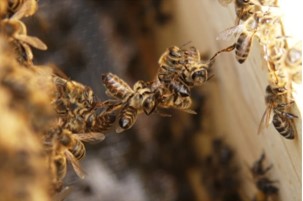
Bees "Festooning" (measuring) for building comb.
Video of bees festooning.https://beemission.com/blogs/news/honey-bees-festooning
Honey bee workers have four pairs of special wax-secreting glands on the undersides of their abdomens. From these glands, they secrete liquified wax, which hardens into thin scales when exposed to the air. As the worker bee ages, these glands atrophy and the task of making wax is left to younger bees.
For the wax-making bees to secrete wax, the ambient temperature in the hive must be 33 to 36 °C (91 to 97 °F). Honey in fat cells associated with wax glands are metabolized by bees into beeswax.
Beeswax is a complex mixture (more than 300 components) of hydrocarbons, free fatty acids, esters of fatty acids and fatty alcohol, diesters and exogenous substances.
Honey bees use wax to build comb that forms their nest and the intricate hexagonal cells that make up that comb. These wax cells are used to house the various stages of bee young (or brood) as they develop from egg to adulthood. In addition wax cells are used to store pollen and nectar.
Wax is produced as needed by worker bees to form and repair comb and individual cells. The wax is secreted by these worker bees, from eight special wax glands situated on the underside of their abdomens (inside the protective plates or sternites of abdominal segments 4 to 7). Worker bees produce wax most efficiently during the 10th through to the 16th days of their lives and this declines steadily from day 18 until the end of life.
When wax is required these workers fill themselves up with honey and then hang together in clusters, known as "Festooning", to contain the heat generated by the metabolism of the honey in their muscles. This resultant rise in temperature allows the wax to be secreted from the bee’s wax glands and this secreted wax then pours into special holders beneath these glands and solidifies.
Eyes
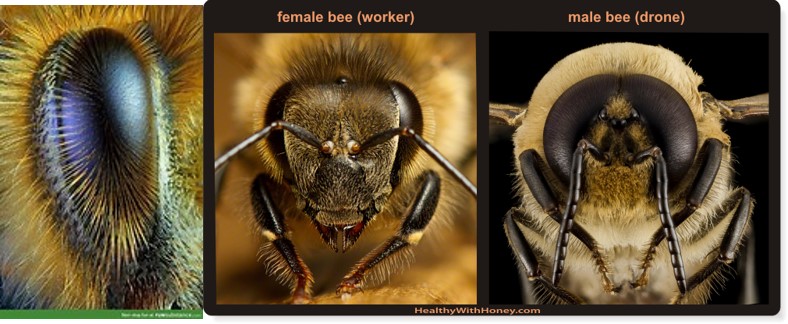
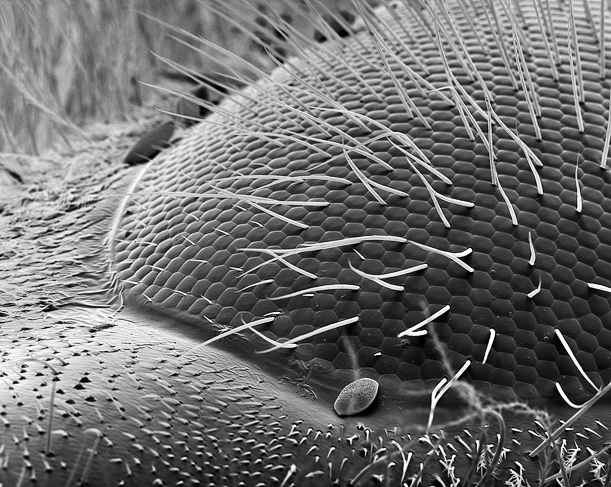

Honey bees have five eyes, two large compound eyes, one on either side of their head and three smaller eyes, called ocelli, at the top of their heads. The compound eyes have thousands of lenses (ommatidia) which most likely give them a pixilated view of the world. Honey bees can see light, motion, and colors.
The hair on their eyes—the microscopic short hairs are known as setae and help the insect with navigation. As honey bees fly, the hair on their eyes catches the wind to help them figure out direction and speed while traveling. It can also sense levels of humidity in the air and help lead the honey bees toward plants with pollen.
The compound eyes have thousands of lenses (ommatidia) which most likely give them a pixilated view of the world. Honey bees can see light, motion, and colors.
A short hair grows in the intersections of the compound lenses of the eye. These hairs are believed to detect wind direction and may be used by the bees to stay on course in windy conditions.
The ocelli serve as a kind of navigation system allowing the bee to triangulate its position relative to the sun and thus to find its way home.
Wings

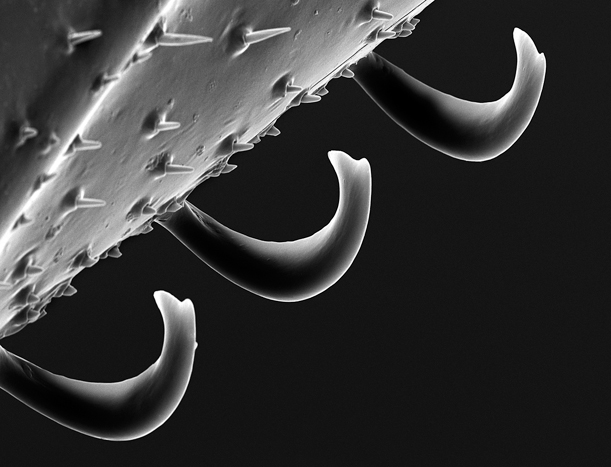
Bees have two wings on each side of their body, which are held together with comb-like teeth called hamuli. These teeth allow the two wings to act as one large surface and help the bee create greater lift when flying.
Legs
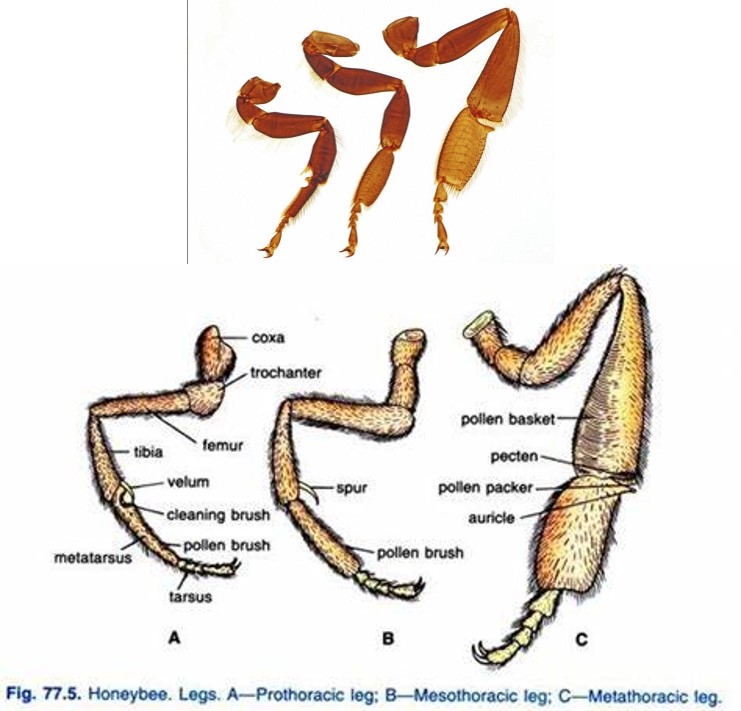

Photo of the front leg spur and notch used to clean the antennae

Photo of the middle leg with the spike for collecting wax.

Photo of the hind leg with the pollen basket.
The honey bee has three pairs of legs that are densely covered with hair and are divided into six segments, making them very flexible. The Coxa, Trochanter, Femur, Tibia, Metatarsus, and the Tarsus.
Coxa
This small segment connects the leg to the thorax of the bee, where it pivots via two joints (articulations).
Each coxa hinges a leg in a particular direction.
The frontal pair, point forward, the middle legs angle slightly backward, and the hind pair are directed towards the back. As the front legs swing forward, the middle and rear legs will swing outward.
Trochanter
In between the coxa and the femur is this tiny section. The trochanter swings in relation to the movement of the coxa. It’s responsible for the upward and downward movement of the whole leg.
Femur
This is a large section of the leg attached to the trochanter via a long and diagonal joint. The connection enables both the trochanter and the femur to move as one unit — which allows for small backward and forward movement.
Tibia
This is the fourth segment of the bee’s legs, which is a joint between the femur and the metatarsus. It’s considered the “knee” of the bee.
The rear tibiae are a different shape — they’re much larger than the other two. The reason being, this is the area bees use to extract pollen from flowers. It’s also the last part of the legs containing muscle.
Metatarsus (Basitarsus)
The fifth segment of the bee’s legs — located between the tibia and tarsus. Unlike the tibia, it doesn’t contain any muscles. Instead, a tendon (unguitractor) runs through it. This enables movement from the metatarsus down to the claws (pre-tarsus).
The metatarsus also contains distinctive pollen-collecting tools such as rows of bristles that form a pollen brush.
Tarsus
This is the final component of the leg — the foot. It comprises of three tarsi and the pre-tarsus (claw). The claws are attached to the tarsus along with an adhesive pad called the arollium. This is what enables the bee to cling onto smooth surfaces.
Bees carry a special gland within the pre-tarsus. As a result, when bees walk, they leave an odor that helps them search for nectar.
Front Leg
The front legs (known as the Prothoracic leg) are specially designed to clean the front of the body, including the antennae, and head and are also used for tasting and removing pollen.
Middle Leg
The middle leg (known as the Mesothorcic leg) remove the pollen from the first pair of legs and the thorax with the flat, wide, hairy tarsal joint, which acts like a brush. On the lower end of the middle legs is a spine, called the spur, which removes plates of wax from the abdomen.
Rear Leg
while the rear legs (known as the Metathoracic leg) have a section devoted to pollen accumulation called a pollen basket. Each leg has claws for gripping and sticky pads to assist the bee in landing on slick surfaces.
